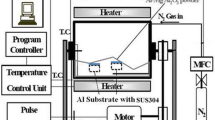Abstract
The demand for hybrid material concepts is steadily growing, and especially dissimilar joints between aluminum and steel are, due to their wide dissemination, of major importance. The main obstacle for the fabrication of aluminum-steel joints using thermal processes is the embrittlement of the fusion area. In order to prevent direct contact between aluminum and iron and thus to suppress the formation of brittle iron aluminides, 3-μm thick diffusion barrier coatings, consisting of Ni or Ti, were applied onto the steel surface. Pure copper with a thickness of 3 and 6 μm, respectively, was used as a filler material, and the samples were brazed in a TLP process in a vacuum at 580 °C at varying dwell times (10…50 min). The samples brazed with Ni diffusion barriers showed a considerable formation of Fe2Al5 even at low dwell times. Furthermore, additional complex ternary phase bands have generated due to the existence of diffusion barrier elements and were detected in the interfacial area. The application of Ti showed a significant decrease of iron aluminides, and no Fe2Al5 could be detected at low dwell times, resulting in a shear strength of 42 MPa for the optimized parameters.














Similar content being viewed by others
References
Hirsch J, Laukli HI (2010) “Aluminium in innovative light-weight car design,” Proc 12th International Conference on Aluminium Alloys, Yokohama pp. 46-53
Hoffmann JM (2006) The secret to strong, reliable adhesive bonding is to start with good clean surfaces. Mach Des 12:92–98
Davis JR (1994) Aluminum and aluminum alloys. ASM International, Material Park
Ryabov V (2001) Welding of Aluminium Alloys to Steel, Harwood, (Amsterdam), pp. 63-69
Lison R (1998) Wege zum Stoffschluss über Schweiß- und Lötprozesse. DVS-Verlag, Düsseldorf
Kreimeyer M (2007) Verfahrenstechnische Voraussetzungen zur Integration von Aluminium-Stahl-Mischverbunden im Kraftfahrzeugbau. Bias Verlag, Bremen
Dilthey U, Höcker F (2006) Lichtbogenfügen und Umformen von Verbindungen aus Stahl und und Aluminium. Schweissen und Schneiden 58(1):23–28
Winiowski A (2009) Structural and mechanical properties of brazed joints of stainless steel and aluminium. Arch Metall Mater 54(2):523–533
M Steffens HD, Wilden J, Möhwald K (1995) Einsatz von ionenplattierten Diffusionsbarrieren und Belotungs-systemen beim Löten von Stahl, 4th Proc. Hart- und Hochtemperaturlöten und Diffusionsschweißen, Aachen pp. 94-98
Aulerich M (2004) Entwicklung von Lötverfahren zum Fügen von hybriden Mikrobauteilen, Mainz, Technical report, Lawrence Livermore National Lab., CA (United States)
Sunwoo AJ (1993) Diffusion bonding of superplastic aluminum alloys, Oak Ridge, Technical report, Lawrence Livermore National Lab., CA (United States)
Tillmann W, Osmanda AM, Wojarski L (2009) Diffusion brazing of Al-alloys for hybrid structures. Q J Jpn Weld Soc 27(2):179–182
Tillmann W, Wojarski L, Osmanda AM (2008) Diffusionslöten von Aluminium mittels PVD applizierter Lotzusatzwerkstoffe. Mater Wiss Werkst 39(9):108–114
Shahverdi HR et al (2002) Microstructural analysis of interfacial reaction between molten aluminum and solid iron. J Mater Process Technol 124:345–352
Tillmann W, Wojarski L (2010) Diffusionsfügeprozesse zur Herstellung von Werkstoffverbunden aus Al-Stahl-Hybridstrukturen. In: Bach F.-W, Plorin T, Tillmann W, (Hrsg): Kolloquium Graduiertenkolleg 1378/1—Herstellung, Bearbeitung und Qualifizierung hybrider Werkstoffsysteme. ProduktionstechnischesZentrum (PZH), Garbsen pp. 88-94
Acknowledgments
The authors would like to thank the German Research Foundation (DFG) for the financial support. We would also like to thank the German Welding Society (DVS) for the travel grant. Likewise, we express our gratitude to Dr. Laemmerhirt for her linguistic assistance.
Author information
Authors and Affiliations
Corresponding author
Additional information
Doc. IIW-2458, recommended for publication by Commission XVII “Brazing, Soldering, and Diffusion Bonding.”
Rights and permissions
About this article
Cite this article
Wojarski, L., Tillmann, W. TLP brazing of aluminum to steel using PVD-deposited interlayer. Weld World 58, 673–680 (2014). https://doi.org/10.1007/s40194-014-0143-x
Received:
Accepted:
Published:
Issue Date:
DOI: https://doi.org/10.1007/s40194-014-0143-x




